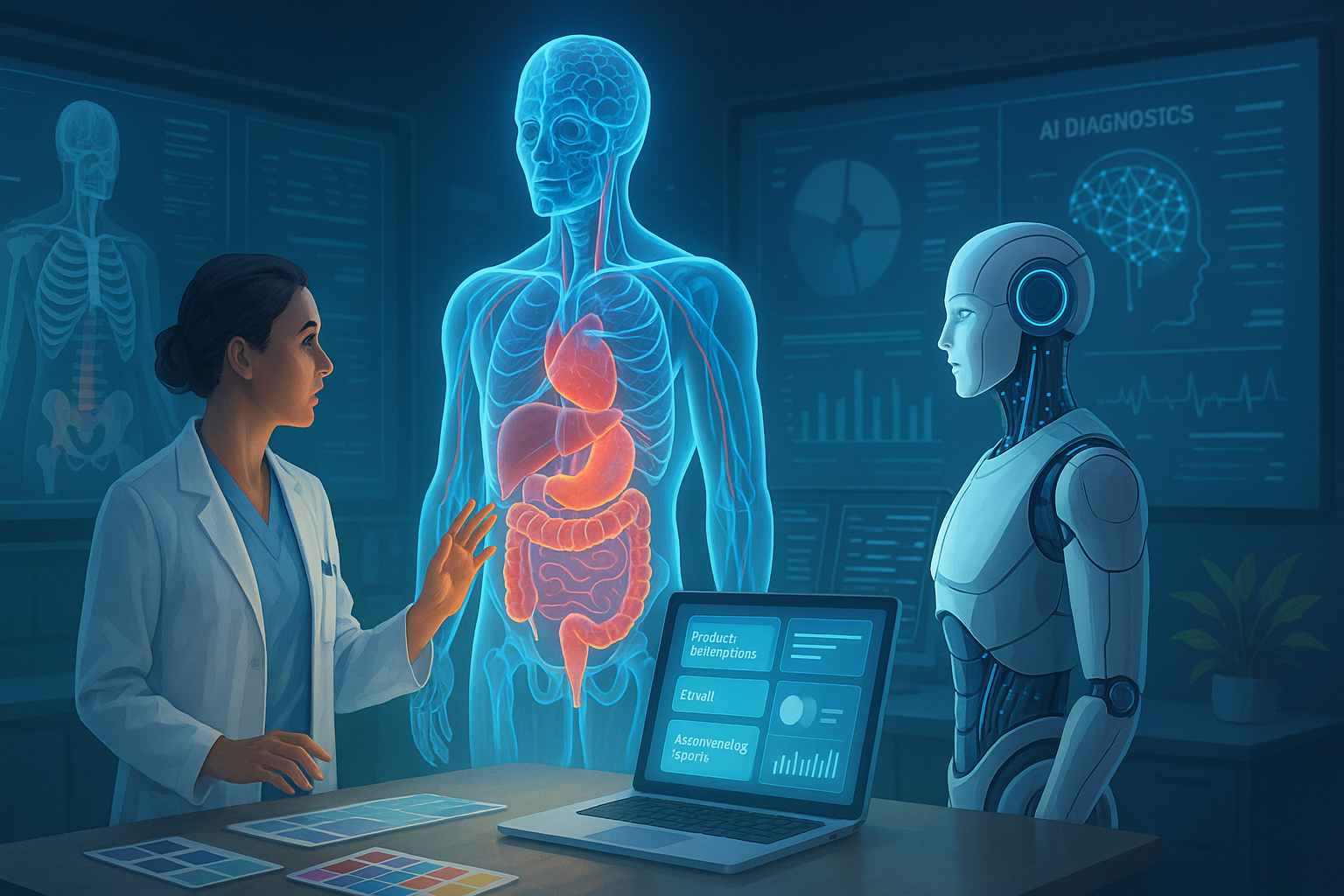Human Anatomy Meets AI: How Tech Understands Us

The Fusion of Anatomy and Artificial Intelligence
Artificial intelligence is transforming nearly every field, and healthcare is no exception. From advanced diagnostics to personalized medicine, AI’s ability to analyze vast amounts of anatomical data is reshaping how we understand the human body. This convergence of technology and biology is not only revolutionizing medical care but also raising important questions about ethics, privacy, and the role of humans in the loop. In this guide, we’ll explore how AI is learning, interpreting, and augmenting human anatomy—and what it means for the future of healthcare and design.
A Brief History of AI in Human Anatomy
Early Efforts in Medical Imaging
Before AI became mainstream, early computational models were already improving medical imaging. Algorithms helped reconstruct CT and MRI scans, reducing noise and enhancing detail. These early innovations laid the groundwork for today’s intelligent systems capable of identifying anatomical structures with high precision.
AI-Powered Diagnostics
As machine learning matured, AI began analyzing imaging data to detect abnormalities like tumors, fractures, and vascular issues. Computer-aided detection systems became valuable second opinions, assisting radiologists in making faster, more accurate diagnoses.
The Rise of Wearable Health Tech
In the past decade, wearable devices like smartwatches and fitness trackers have brought anatomy-informed AI to everyday life. These devices monitor heart rate, movement, sleep, and other physiological signals, providing insights previously only available in clinical settings.
How AI Learns Human Anatomy
Training on Medical Datasets
AI models rely on extensive datasets—millions of images and measurements—to learn the complexities of the human body. Medical institutions contribute anonymized scans and health records, enabling algorithms to recognize patterns that even experienced clinicians might miss.
Neural Networks for Pattern Recognition
Deep learning models, particularly convolutional neural networks (CNNs), excel at identifying anatomical features in images. By analyzing pixel patterns and comparing them to labeled examples, these networks can distinguish healthy tissue from diseased areas with remarkable accuracy.
3D Modeling and Anatomical Simulations
Beyond 2D imaging, AI creates detailed 3D models of organs and systems. These models support surgical planning, virtual training, and biomechanical simulations, offering a more comprehensive view of human anatomy than ever before.
Applications of AI in Understanding Anatomy
Disease Detection and Diagnosis
AI algorithms are transforming how clinicians detect and diagnose disease. From identifying cancerous lesions in mammograms to spotting early signs of diabetic retinopathy in eye scans, AI offers a level of speed and consistency that supports better patient outcomes. These tools serve as decision-support systems, flagging potential issues that require further human review.
Surgical Planning and Precision
AI-powered 3D anatomical models help surgeons plan procedures with unprecedented detail. By simulating surgical approaches and visualizing anatomical variations, doctors can reduce risks and improve precision. Some systems even provide real-time guidance during operations, overlaying anatomical data onto live images to assist in navigation.
Virtual Anatomy Education
AI is reshaping how medical students learn human anatomy. Interactive platforms powered by AI can adapt to a learner’s pace, highlight key structures, and simulate pathological conditions. This personalized approach makes anatomy education more engaging and effective than static textbooks or cadaver labs alone.
AI-Powered Imaging Technologies
CT and MRI Enhancement
Modern AI tools clean up noise, sharpen details, and even reconstruct missing data in CT and MRI scans. This improves diagnostic confidence and reduces the need for repeat imaging, which can lower costs and limit radiation exposure for patients.
Ultrasound Interpretation
Ultrasound is notoriously challenging to interpret due to variability in image quality and operator skill. AI systems assist clinicians by identifying anatomical landmarks, measuring structures, and detecting anomalies in real time, making ultrasound more accessible and reliable.
Real-Time Imaging in Surgery
Intraoperative imaging enhanced by AI gives surgeons dynamic, up-to-date views of the body. For example, AI can process live video feeds to identify blood vessels or critical structures, helping prevent accidental injury and improving surgical outcomes.
Wearables and Personalized Anatomy Insights
Biometric Monitoring and AI Analysis
Wearable devices now track detailed biometric data, from heart rate variability to oxygen saturation. AI analyzes these streams in real time, identifying trends and alerting users or clinicians to potential health concerns before they escalate.
Posture, Movement, and Gait Analysis
AI-powered wearables assess how we move, sit, and stand. For athletes, this data can optimize performance and prevent injuries. For clinical populations, it provides valuable insights into rehabilitation progress and fall risk assessment.
Predictive Health Insights
By combining biometric data with medical history, AI can anticipate health issues and recommend proactive steps. For example, predictive algorithms can estimate the likelihood of a cardiac event or identify early signs of musculoskeletal disorders.
AI and the Musculoskeletal System
Bone Density and Fracture Risk Prediction
AI algorithms analyze bone scans to assess density and predict fracture risk with remarkable accuracy. Tools like automated DEXA scan interpretation help doctors detect osteoporosis earlier, enabling proactive treatment to strengthen bone health and reduce injury.
Joint Health and Arthritis Monitoring
Advanced imaging systems powered by AI can identify early signs of arthritis and track disease progression over time. These insights support tailored treatment plans, helping patients maintain mobility and reduce discomfort.
Athletic Performance Optimization
Elite athletes and trainers are using AI-driven movement analysis to improve performance. By studying joint angles, muscle engagement, and biomechanics, AI provides actionable recommendations that enhance strength, efficiency, and injury prevention.
AI and the Nervous System
Brain Mapping and Neurological Imaging
AI helps interpret complex neurological scans, including fMRI and PET images. Algorithms can map brain activity, identify lesions, and detect conditions such as Alzheimer’s or epilepsy earlier than traditional methods. This detailed understanding aids in more precise diagnoses and treatment planning.
AI in Cognitive and Mental Health Assessment
Natural language processing (NLP) models analyze speech and text to assess cognitive function and detect early signs of dementia or depression. These tools provide clinicians with additional insights, supporting more holistic care strategies.
Neural Prosthetics and Interfaces
AI is driving innovation in neural interfaces, translating brain signals into commands for prosthetic limbs and assistive devices. These technologies are restoring function and independence to people with paralysis or limb loss, demonstrating the profound impact of AI on human capability.
Ethical and Privacy Considerations
Data Security in Medical AI
Medical data is highly sensitive. Robust encryption, secure storage, and compliance with regulations like HIPAA and GDPR are essential to protect patient information. AI developers must prioritize privacy to maintain trust in these technologies.
Bias and Fairness in Anatomical Models
AI models trained on non-diverse datasets can perpetuate biases, leading to inaccurate diagnoses or unequal care. Ensuring datasets represent different ages, genders, ethnicities, and health conditions is critical for fairness and inclusivity.
Informed Consent and Transparency
Patients should understand how their data will be used, including any AI-driven analyses. Clear communication and consent processes help individuals make informed decisions about their care and data sharing.
Interdisciplinary Collaboration
Engineers and Medical Professionals
The development of anatomy-aware AI requires close collaboration between engineers and healthcare providers. Engineers bring expertise in data science and machine learning, while clinicians contribute deep knowledge of anatomy, pathology, and patient care. Together, they create tools that are both technically robust and clinically relevant.
Designers and Human Factors Experts
Designers and human factors specialists ensure that AI-powered systems are accessible and intuitive. From clear visualizations to user-friendly interfaces, their work helps clinicians and patients understand complex anatomical insights without confusion.
AI Researchers and Ethicists
As AI becomes more integrated into healthcare, ethicists play a critical role in guiding responsible development. They help teams address questions of bias, consent, and transparency, ensuring that new technologies respect human dignity and rights.
Challenges and Limitations
Data Quality and Diversity
High-quality, diverse datasets are essential for training reliable AI models. However, gathering sufficient data across populations can be difficult due to privacy concerns, inconsistent standards, and logistical barriers. Without representative data, models risk being inaccurate or biased.
Interpreting Complex Biological Systems
The human body is extraordinarily complex. Even advanced AI struggles to capture every nuance of anatomy and physiology. Ensuring models can generalize across variations—like anatomical differences or rare conditions—remains a significant challenge.
Regulatory Hurdles
Bringing AI-powered medical tools to market requires rigorous testing and approval from regulatory bodies like the FDA. These processes are necessary to protect patient safety but can also slow innovation and adoption.
The Future of Anatomy-Aware AI
AI-Driven Prosthetics and Augmentation
Next-generation prosthetics are integrating AI to interpret neural signals and mimic natural movement. These advancements promise to restore mobility and enhance quality of life for millions of people worldwide.
Personalized Medicine at Anatomical Level
AI will increasingly enable treatments tailored to each individual’s anatomy. From custom surgical guides to personalized drug delivery systems, this level of precision will redefine standards of care.
AI in Regenerative Medicine
AI is accelerating breakthroughs in tissue engineering and regenerative therapies. By modeling cellular behavior and optimizing lab-grown tissues, AI could one day help regenerate damaged organs or repair injuries more effectively than ever before.
Practical Steps for Integrating AI with Anatomy-Based Applications
Building Inclusive Medical Datasets
To create fair and accurate AI models, organizations must invest in collecting diverse datasets. Collaborating with multiple institutions and ensuring demographic representation across age, ethnicity, and health conditions strengthens the reliability and equity of AI systems.
Testing and Validating AI Models
Thorough validation is critical before deploying AI in clinical settings. Models must be rigorously tested against real-world scenarios to confirm accuracy, consistency, and generalizability. Ongoing monitoring ensures performance remains high as new data becomes available.
Designing Human-Centered Interfaces
Effective AI tools must be easy for clinicians and patients to understand and use. Designing intuitive dashboards, clear visualizations, and responsive interfaces ensures that technology supports—not hinders—care delivery.
Conclusion: Toward a Deeper Tech-Driven Understanding of the Human Body
The convergence of human anatomy and artificial intelligence is unlocking new frontiers in medicine, design, and human performance. From detecting disease earlier to personalizing treatments, AI is helping us understand the body with a level of precision once thought impossible. As this technology evolves, careful attention to ethics, privacy, and inclusivity will ensure that AI serves everyone equitably. The future of health is not just digital—it’s deeply human.
Frequently Asked Questions
How does AI learn human anatomy?
AI learns anatomy by training on large datasets of medical images and records. Algorithms identify patterns, structures, and anomalies by comparing new inputs to labeled examples.
Is AI reliable for medical diagnosis?
AI has proven highly effective in many areas, such as radiology and dermatology. However, it should be viewed as a decision-support tool rather than a replacement for professional medical judgment.
What are the risks of using AI in healthcare?
Potential risks include data privacy breaches, biased predictions due to unbalanced datasets, and overreliance on automated recommendations. Transparency and oversight are essential to mitigate these issues.
Can AI replace doctors in anatomy analysis?
No—AI can enhance and support clinicians but cannot replicate the experience, intuition, and empathy of a human professional. The best outcomes come from collaboration between AI and skilled practitioners.
How is privacy protected in AI anatomy systems?
Strict regulations like HIPAA and GDPR govern how medical data is stored and shared. Encryption, anonymization, and secure infrastructure protect patient information from unauthorized access.
Editor’s Choice
Get started with our best stories
Get all the latest posts delivered straight to your inbox.



